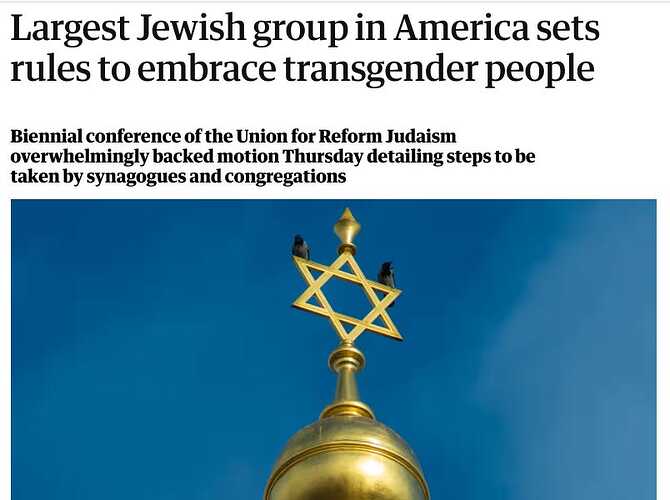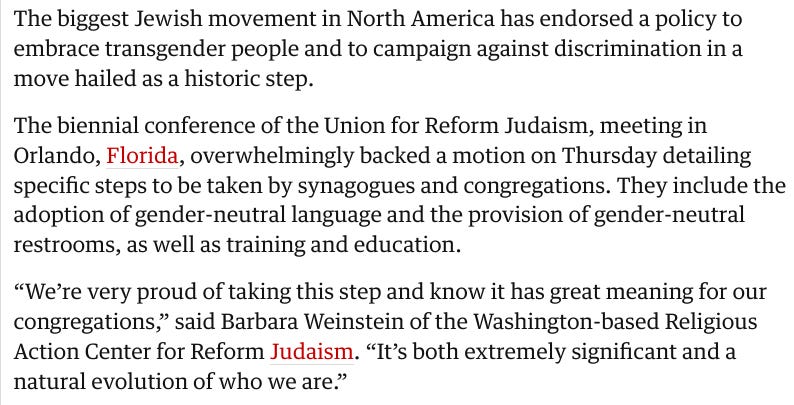THREAD: TransMovement is Jewish?
https://decentralisep.substack.com/p/thread-transmovement-is-jewish
“An androgynous, who presents both male and female physical traits, is in some ways like men and in some ways like women. In some ways, they are like both men and women, and in other ways, like neither men nor women." (Bikkurim 4:1) The Talmud
Why do so many leading Jewish academics and institutions push the Transgender movement?
We read headlines like this frequently, many Jewish journalists and Academics support the infiltration of Transgender acceptance in our institutions. They want our children questioning not only their sexuality, but also their gender. In addition to this, they brainwash the children into becoming activists for a compelled set of new norms. What doctrine drives this new cultural phenomenon in the West?
The Talmud, a comprehensive compilation of Jewish legal traditions, identifies eight gender designations, including male, female, androgynous (both male and female characteristics), tumtum (lacking sexual characteristics), aylonit hamah (female at birth but later developing male characteristics), aylonit adam (female at birth but later developing male characteristics through intervention), saris hamah (male at birth but later developing female characteristics), and saris adam (male at birth and later developing female characteristics through intervention).
The Holy Bible: King James Version. (Deuteronomy 22:5) states:
“A woman shall not wear that which pertaineth unto a man, neither shall a man put on a woman’s garment; for whosoever doeth these things is an abomination unto the LORD thy God.”
In Western society, the prevailing approach to gender, rooted in Christian thought, perceives both sex and gender as binary concepts. Classical rabbinic Judaism, however, presents a more nuanced understanding, as reflected in the Talmud's recognition of diverse gender categories.
The Talmud emphasises that sex organs do not strictly define one's gender. The Mishna underscores this perspective, stating, "The androgynous is like a man in some ways and like a woman in some ways, like both a man and a woman in some ways, and like neither a man nor a woman in some ways" (Bikurim 4.1). Despite lacking knowledge of modern concepts like chromosomes, the rabbis expressed the independence of sex and gender, permitting individuals to authentically express their gender identity.
The Talmud instead, says that what is prohibited is falsifying identity for the purpose of spying on the other sex. The mediaeval commentator Rashi says that the prohibition is limited to concealing identity for the purpose of adultery. The Shulhan Arukh notes that cross-dressing is permitted on Purim because its purpose is simha (celebration, joy) and that it is only forbidden if it is for the purpose of fraud. In limiting the prohibition to situations of fraud and deception, the talmudic and mediaeval rabbis indicated that cross-dressing in a way that is true to the cross-dresser’s identity is permitted.
The imperative for inclusion aligns with the belief that every person is b'tzelem Elohim (in the image of God), contributing to the divine presence. Tzedek, the pursuit of justice, compels Jews to combat injustice faced by transgender individuals.
Jewish communities are encouraged to adopt inclusive nondiscrimination policies, including transgender individuals in employment guidelines. Facilities should provide single-stall restrooms to ensure privacy and avoid embarrassment. Regular programming addressing gender diversity should be integrated into Jewish communal life.
There are striking parallels with feminism, in that the consequences of these ideologies conflate to a point of overlapping one another.
Author of Theology of Home Carrie Gress states:
“Hulking "trans women" thrash female athletes. Mothers abort their baby girls. Drag queens perform obscene parodies of women. Females are enslaved for men's pleasure--or they enslave themselves. Feminism doesn't avert these tragedies; it encourages them. The carefree binge of self-absorption has left women exploited, unhappy, dependent on the state, and at war with men. And still, feminists cling to their illusions of liberation.”
The notion of allowing individuals to self-identify as a gender different from their biological sex, participate in sports, and use facilities corresponding to that gender is deeply concerning. What is also concerning is that women have been misled into abandoning their biological roles, leaving them with little at the end of their careers.The Talmudic Jews, seemingly aim to discourage reproduction among the general population.
Sha'ar Hagilgulim is a Kabbalist work on Gilgul , the concept of reincarnation put together by Rabbi Hayyim Vital who recorded the teachings of his master Itzhak Luria in the 16th century CE, Chapter 9 suggests (paraphrasing):
‘Sometimes a man may reincarnate into the body of a woman because of a sin, such as homosexuality or something similar. This woman who has received the soul of a man will not be able to conceive and become pregnant.’
Now, we could continue with these examples from Jewish tradition, but it would bore us and miss the point of what Carrie Gress stressed in the previous quote. While Jews may believe this doctrine aligns with Tikkun Olam, it is evident that it is incompatible with the West. The utopian ideal of Kabbalah, whether benevolent in intent or not, is a form of cultural subversion to Westerners and Christianity.
There is also evidence that the ideological drive for the Transgender movement is a cascade of increasingly extreme agendas. Feminism, Civil Rights and Gay rights movements were the precursors to the Marxist-fueled LGBTQ+, BLM, and the worrisome Paedophile cult movement. The drive to push this on non-Jewish children of the West appears to be a direct subversion of our cultural ethos. This aligns much with the Talmudic scripture that calls for a World Kingdom of the Jews with a subclass of human cattle, known contemporarily as the ‘Goyim’.

